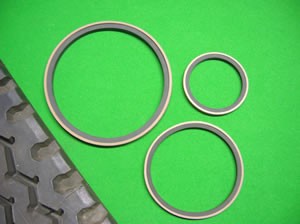 Double acting PTFE composite piston seal
Double acting PTFE composite piston seal
Suitable for compact housings, low friction, high integrity seal. Standard material is 40% bronze filled (green) PTFE and 70 shore A nitrile O-ring energizer
 Single acting PTFE composite piston seal.
Single acting PTFE composite piston seal.
Suitable for compact housings, low friction, high integrity seal. Standard material is 40% bronze filled PTFE (green) and 70 shore A nitrile O-ring energizer
Uses of the Composite Piston Seal
Combined sealing assemblies consisting of a sealing ring made of PTFE and an elastomeric O-ring are widely used in a wide variety of equipment such as presses, injection moulding machines, machine tools e.g. milling machines, in equipment for the food and pharmaceutical industry such as filling, metering and mixing units as well as in mobile hydraulics e.g. excavators and forest machinery.
 1.1. Requirements for a Composite seal
1.1. Requirements for a Composite seal
Composite seals are often used in systems that are working at very low speed and high control accuracy.
This kind of seal must meet the following
- Low friction and no occurrence of stick-slip
- Low leaking rates
- Long lifetime, which means high wear resistance
- Resistance against pressure and extrusion
- Easy to install
Normally a composite piston seal based on a sliding element made of PTFE or a PTFE compound meets the following requirements:
- Due to the outstanding friction behaviour of PTFE based materials, low friction and the avoidance of stick slip can be guaranteed for these seals if a suitable lubricant is used in the system.
- Most compounds show acceptable pressure and extrusion resistance; problems can occur if unsuitable compounds are used or operated with too large an extrusion gap.
Looking to the remaining requirements, some weak points of these seal combinations become visible.
- Normally a composite piston seal in particular if used as rod seals, show relatively high rates of leakage. To improve the sealing performance it is necessary to mount these seals in a tandem configuration [1, 2, 3], that means to combine either two composite seals or one composite seal with an U-ring or lip seal made of polyurethane or an elastomer.
- In general the wear resistance of PTFE materials, compared to many other polymers, is mediocre to moderate [4, 5], and therefore an acceptable lifetime can only be attained if a fully developed lubrication film exists. Furthermore the poor wear properties and especially the notch sensibility of PTFE can cause damage during the fitting process and lead to unacceptable leakage and breakdown of the seal through leakage wear. Small defects or damage to the seal by a scored, scratched or indented rod can lead to the same result.
- Due to the limited elasticity and therefore high residual deformation of PTFE materials, fitting and subsequent calibration of the seals must be done very carefully.



